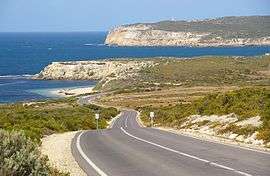Cape Spencer (South Australia)
| Cape Spencer South Australia | |||||||||||||
|---|---|---|---|---|---|---|---|---|---|---|---|---|---|
|
Path to Cape Spencer lighthouse, Innes National Park | |||||||||||||
 Cape Spencer | |||||||||||||
| Coordinates | 35°18′0″S 136°53′0″E / 35.30000°S 136.88333°ECoordinates: 35°18′0″S 136°53′0″E / 35.30000°S 136.88333°E | ||||||||||||
| Elevation | 79 m (259 ft)[1] | ||||||||||||
| LGA(s) | Yorke Peninsula Council | ||||||||||||
| |||||||||||||
| |||||||||||||
| Footnotes | Climate[2] | ||||||||||||

Cape Spencer is a headland located on the south west tip of Yorke Peninsula in South Australia. It was named after George Spencer, 2nd Earl Spencer by Matthew Flinders during March 1802. It has been the site of an operating navigation aid since 1950 and has been located within the Innes National Park since 1970.
Description
Cape Spencer is located about 125 kilometres (78 mi) south west of Maitland. It is the most south westerly point of the Yorke Peninsula coast and defined by Flinders as being the eastern side of the mouth of Spencer Gulf.[3] It is the termination for a pair of coastlines - the western coastline extending from Corny Point in the nouth and the southern coastline extending from Troubridge Point in the east.[4] It is described as appearing ‘as a cone with a ledge of rocks at its base’ when viewed from the south.[1] Cape Spencer is accessible via a walking trail from within the Innes National Park. Access extends to the area around the Cape Spencer Lighthouse where views of both the adjoining coastline and nearby islands are available and the presence of interpretative signage provides information about the locality’s maritime history.[5]
Formation, geology & oceanography
Cape Spencer was formed when the sea reached its present level 7,500 years ago after sea levels started to rise at the start of the Holocene.[6] The cliff line which includes Cape Spencer consists of base strata of both Gleesons Landing Granite and Tourneforte Metadolerite with an overlay of a Bridgewater Formation calcarenite rock.[7] The water adjoining the wave-cut platform at the base of Cape Spencer drops to a maximum depth of 14.8 metres (49 ft).[8]
History
European discovery
Cape Spencer was named on 20 March 1802 by Matthew Flinders after George Spencer, 2nd Earl Spencer who was one of the Lords Commissioners of the Admiralty in office at the time of the planning of the expedition to New Holland, or Terra Australis as Flinders called the continent in his book, A Voyage to Terra Australis.[3] The cape was subsequently also named by the Baudin expedition to Australia as Pointe Mornay or Pointe des Malfaisants (English: 'Point of Evil').[9]
Navigation aid and allied facilities
The current concrete lighthouse was built in 1975 to replace a small automatic beacon erected in 1950.[10] The cape is also the site of a high frequency radar station which is used to collect data about wind direction and wave height.[11]
Protected area status
Cape Spencer has been located within the protected area known as the Innes National Park since the park's declaration in 1970.[12] As of 2012, the waters surrounding its shores are within the boundaries of a habitat protection zone within the Southern Spencer Gulf Marine Park.[13]
References
- 1 2 Pub175, Sailing directions (enroute) north, west, and south coast of Australia (PDF) (10th ed.). National Geospatial-Intelligence Agency. 2010. p. 183. Retrieved 16 May 2014.
- ↑ "Monthly climate statistics: Summary statistics STENHOUSE BAY". Commonwealth of Australia , Bureau of Meteorology. Retrieved 30 November 2015.
- 1 2 Flinders, Matthew (1966) [1814]. A Voyage to Terra Australis : undertaken for the purpose of completing the discovery of that vast country, and prosecuted in the years 1801, 1802, and 1803 in His Majesty's ship the Investigator, and subsequently in the armed vessel Porpoise and Cumberland Schooner; with an account of the shipwreck of the Porpoise, arrival of the Cumberland at Mauritius, and imprisonment of the commander during six years and a half in that island. (Facsimile ed.). Adelaide; Facsimile reprint of: London : G. and W. Nicol, 1814 ed. In two volumes, with an Atlas (3 volumes): Libraries Board of South Australia. p. 249. Retrieved 27 March 2013.
- ↑ Hydrographic Department, Ministry of Defence (1983). Gulf of St Vincent and approaches (chart no. 1762). (reproduced by the Royal Australian Navy Hydrographic Service).
- ↑ Cape Spencer Lighthouse - SouthAustralia.com. Retrieved 2014-01-01.
- ↑ Robinson, A. C. & Armstrong, D. M. (ed.). A Biological Survey of Kangaroo Island, South Australia, 1989 & 1990 (PDF). Adelaide, SA: Heritage and Biodiversity Section, Department for Environment, Heritage and Aboriginal Affairs, South Australia. p. 26. ISBN 0 7308 5862 6. Retrieved 1 May 2014.
- ↑ Fairclough, Martin C (December 2007). "KINGSCOTE Special 1:250 000 geological map" (PDF). MESA Journal (Government of South Australia, DMITRE) 47: 28–31. ISSN 1326-3544. Retrieved 18 May 2014.
- ↑ South Australia. Department of Marine and Harbors (1985), The Waters of South Australia a series of charts, sailing notes and coastal photographs, Dept. of Marine and Harbors, South Australia, pp. Charts 23, ISBN 978-0-7243-7603-2
- ↑ Property Location Browser V2 - Government of South Australia - Department of Planning, Transport & Infrastructure. Retrieved 2014-01-01
- ↑ "Cape Spencer(2)". Russ Rowlett and the University of North Carolina at Chapel Hill. Retrieved 31 December 2013.
- ↑ "IMOS - ACORN - Cape Spencer HF ocean radar station (South Australia Gulfs, South Australia, Australia)". Research Data Australia. Retrieved 27 March 2015.
- ↑ "Innes National Park Management Plan" (PDF). Department for Environment and Heritage. 2003. pp. 5 & 28. Retrieved 24 June 2014.
- ↑ "Southern Spencer Gulf Marine Park Management Plan" (PDF). Department of Environment, Water and Natural Resources. p. 26 of 27. Retrieved 24 June 2014.
| ||||||||||||||||||||||||||||||||||||||||||||||||||||||